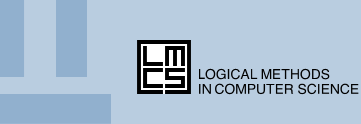 |
 |
Home
We incorporate strong negation in the theory of computable functionals TCF, a common extension of Plotkin's PCF and G\"{o}del's system T, by defining simultaneously strong negation AN of a formula A and strong negation PN of a predicate P in TCF. As a special case of the latter, we get strong negation of an inductive and a coinductive predicate of TCF. We prove appropriate versions of the Ex falso quodlibet and of double negation elimination for strong negation in TCF. We introduce the so-called tight formulas of TCF i.e., formulas implied by the weak negation of their strong negation, and the relative tight formulas. We present various case-studies and examples, which reveal the naturality of our definition of strong negation in TCF and justify the use of TCF as a formal system for a large part of Bishop-style constructive mathematics.
Published on April 4, 2025
Order-invariant first-order logic is an extension of first-order logic FO where formulae can make use of a linear order on the structures, under the proviso that they are order-invariant, i.e. that their truth value is the same for all linear orders. We continue the study of the two-variable fragment of order-invariant first-order logic initiated by Zeume and Harwath, and study its complexity and expressive power. We first establish coNExpTime-completeness for the problem of deciding if a given two-variable formula is order-invariant, which tightens and significantly simplifies the coN2ExpTime proof by Zeume and Harwath. Second, we address the question of whether every property expressible in order-invariant two-variable logic is also expressible in first-order logic without the use of a linear order. We suspect that the answer is ``no''. To justify our claim, we present a class of finite tree-like structures (of unbounded degree) in which a relaxed variant of order-invariant two-variable FO expresses properties that are not definable in plain FO. By contrast, we show that if one restricts their attention to classes of structures of bounded degree, then the expressive power of order-invariant two-variable FO is contained within FO.
Published on March 28, 2025
We study the enumeration of answers to Unions of Conjunctive Queries (UCQs) with optimal time guarantees. More precisely, we wish to identify the queries that can be solved with linear preprocessing time and constant delay. Despite the basic nature of this problem, it was shown only recently that UCQs can be solved within these time bounds if they admit free-connex union extensions, even if all individual CQs in the union are intractable with respect to the same complexity measure. Our goal is to understand whether there exist additional tractable UCQs, not covered by the currently known algorithms. As a first step, we show that some previously unclassified UCQs are hard using the classic 3SUM hypothesis, via a known reduction from 3SUM to triangle listing in graphs. As a second step, we identify a question about a variant of this graph task that is unavoidable if we want to classify all self-join-free UCQs: is it possible to decide the existence of a triangle in a vertex-unbalanced tripartite graph in linear time? We prove that this task is equivalent in hardness to some family of UCQs. Finally, we show a dichotomy for unions of two self-join-free CQs if we assume the answer to this question is negative. In conclusion, this paper pinpoints a computational barrier in the form of a single decision problem that is key to advancing our understanding of the enumeration complexity of many UCQs. Without a breakthrough for unbalanced triangle detection, we have no hope of finding an […]
Published on March 27, 2025
This paper is concerned with games of infinite duration played over potentially infinite graphs. Recently, Ohlmann (LICS 2022) presented a characterisation of objectives admitting optimal positional strategies, by means of universal graphs: an objective is positional if and only if it admits well-ordered monotone universal graphs. We extend Ohlmann's characterisation to encompass (finite or infinite) memory upper bounds. We prove that objectives admitting optimal strategies with ε-memory less than m (a memory that cannot be updated when reading an ε-edge) are exactly those which admit well-founded monotone universal graphs whose antichains have size bounded by m. We also give a characterisation of chromatic memory by means of appropriate universal structures. Our results apply to finite as well as infinite memory bounds (for instance, to objectives with finite but unbounded memory, or with countable memory strategies). We illustrate the applicability of our framework by carrying out a few case studies, we provide examples witnessing limitations of our approach, and we discuss general closure properties which follow from our results.
Published on March 24, 2025
We consider the problems of language inclusion and language equivalence for Vector Addition Systems with States (VASS) with the acceptance condition defined by the set of accepting states (and more generally by some upward-closed conditions). In general, the problem of language equivalence is undecidable even for one-dimensional VASS, thus to get decidability we investigate restricted subclasses. On the one hand, we show that the problem of language inclusion of a VASS in k-ambiguous VASS (for any natural k) is decidable and even in Ackermann. On the other hand, we prove that the language equivalence problem is already Ackermann-hard for deterministic VASS. These two results imply Ackermann-completeness for language inclusion and equivalence in several possible restrictions. Some of our techniques can be also applied in much broader generality in infinite-state systems, namely for some subclass of well-structured transition systems.
Published on March 20, 2025
Managing Editors
Stefan Milius
Editor-in-Chief
Brigitte Pientka
Fabio Zanasi
Executive Editors
Editorial Board
Executive Board
Publisher
eISSN: 1860-5974
Logical Methods in Computer Science is an open-access journal, covered by SCOPUS, DBLP, Web of Science, Mathematical Reviews and Zentralblatt. The journal is a member of the Free Journal Network. All journal content is licensed under a Creative Commons license.